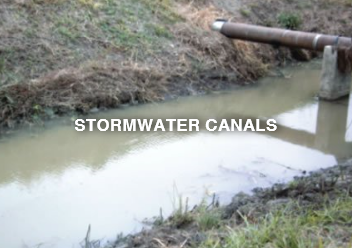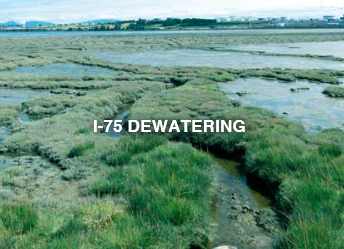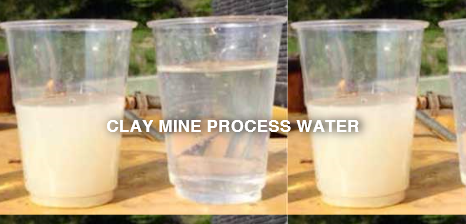Coal Ash Composition
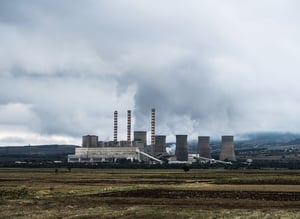 Coal combustion residuals (CCRs), or coal ash, is the waste from coal-fired power plants, and is composed of contaminants like mercury, cadmium, arsenic and chromium, which are associated with serious health effects.
Coal combustion residuals (CCRs), or coal ash, is the waste from coal-fired power plants, and is composed of contaminants like mercury, cadmium, arsenic and chromium, which are associated with serious health effects.
Coal ash can be disposed of in two main ways: by placing it in a dry landfill, or dumping it in a surface pond. The issue posed by dry landfills is that the wind can carry away this toxic coal ash and cause pollution (i.e. acid rain).
Coal ash ponds trap the ash so that it cannot be carried away by the air, however it does pose issues of its own. When coal ash is combined with water, it frees the heavy metals found in coal combustion residuals from their bonds. When a liner is not present, this allows the heavy metals to leach out of the pond and into the groundwater. Leaching occurs when water percolates through the soil, drawing contaminants (heavy metals) away from the ash. Even with a liner, if this pond were to spill, that would spell danger to the populations living in the area.
Often collected in coal ash ponds adjacent to natural waterways, coal ash is subject to new EPA regulations, along with increased pressure to close or relocate many of the ponds due to the adverse health effects associated with pond leaching or spills.
Dober’s naturally-sourced and cost-effective solutions can help you proactively treat your coal ash ponds, protecting the surrounding community and environment.
The dangers that coal ash contaminants pose can lead to health issues such as birth defects and cancer in the populations that drink this water. In the United States, there are coal ash pond locations in 47 out of 50 states, totaling over 1,100 ponds, many of which are surrounded by residential areas. The location of coal ash ponds and their proximity to local residences plays a large factor in the danger of these disposal methods. If there were to be another pond spill near a residential area, such as the Tennessee Valley Authority Spill, great health dangers would be imposed on the community.
Do The Right Thing
One of Dober’s core pillars is to “Do The Right Thing”. Dober’s water treatment division was created in the 1970s in response to the Clean Water Act. We aim to do the right thing by being responsible stewards of our environment and being proactive in treating water using naturally sourced, environmentally friendly chemicals.
Right now, the law doesn’t require companies to close coal ash ponds as long as they have an impermeable liner. However, this does nothing to prevent the possibility of a spill. We believe in protecting our natural waterways and our community; this can be done by closing coal ash ponds before they leak into the environment. In order to close a pond, it must be dewatered, meaning the water is drained from the pond and the suspended solids are separated out using chemical treatment.
Chemistries such as coagulants and flocculants are commonly used in the process of closure and dewatering of coal ash ponds to treat the water for these suspended solids and metals. Dober’s Water Treatment portfolio of coagulants and flocculants offers natural chemistry solutions for treating contaminated water before it is released into the environment.
Coal Ash Pond EPA Regulation History
On June 21, 2010, the EPA first published proposed regulations under the Resource Conservation and Recovery Act (RCRA) to address the safe disposal of coal ash generated by electric utilities and independent power producers. Until then, the EPA had not provided standards to guide state and private sector disposal of coal ash.
How to designate Coal Ash?
Under RCRA, coals ash is regulated as non-hazardous solid waste. This rule became effective on October 4, 2016, and established minimum national standards for coal ash landfills and ponds regarding location restrictions, design and operating criteria, inspections, groundwater monitoring, corrective action, closure, and various reporting and recordkeeping requirements.
The primary goals of the EPA regulations are:
- Promoting environmentally sound disposal methods
- Maximizing the reuse of recoverable resources
- Fostering resource conservation
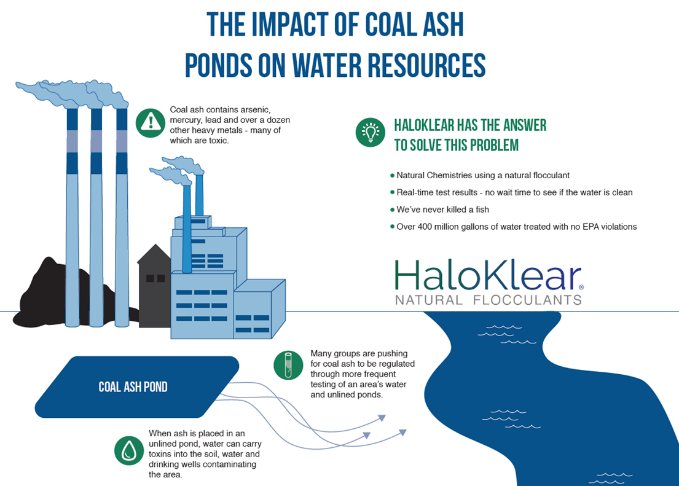
The Bottom Line
The EPA’s regulation on coal ash ponds and landfills gives detailed guidelines for coal ash disposal, but the bottom line is this: any active coal ash retention pond or landfill must have an impermeable liner between itself and the Earth or it must be closed. We believe in going above and beyond this rule, and treating coal ash pond water for toxic heavy metals before they have a chance of reaching the environment, whether there is a liner or not.
Coal Ash Disposal Methods
Most commonly, coal ash is disposed of in landfills or retention ponds. The EPA regulations cover standards for water being returned to natural waterways after pond remediation, as well as requirements for monitoring of groundwater around surface impoundments or landfills to ensure contaminants are not leaching into surrounding areas. Leaching carries contamination away from these ponds and into natural waterways.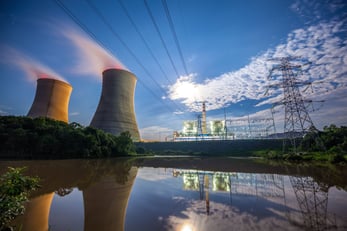
While new disposal methods are emerging, such as treating the ash for metals and returning it to the coal mines, there are still thousands of coal ash ponds and landfills across the country that have been used historically for coal ash disposal. When water from these sites enters the environment, it brings harmful heavy metals with it. These sites need to be remediated to prevent them from continued environmental pollution. While nothing can be done to proactively treat the water that enters landfills and leaches heavy metals, these sites can still be surrounded and covered by impermeable liners to prevent water from reaching them in the first place.
The water that goes into the coal ash ponds will eventually return to the environment, whether on purpose (through closure and dewatering) or on accident (through leaching or spilling). Rather than waiting for an accident to occur, we believe in closing and dewatering these ponds (coal ash pond remediation) as the best method of preventing pollution. Coal ash pond remediation through closure would entail dewatering, decontaminating the coal ash, and disposing of it in a location with a final impermeable cover. The dewatering process drains water from coal ash ponds and uses chemistry to remove pollutants, such as heavy metals and other suspended solids. Dober’s Water Treatment portfolio of industrial, plant-based natural coagulants, natural flocculants and water clarifiers offers an environmentally friendly, sustainable, low-cost solution for dewatering coal ash surface impoundments. Our unique, 100% biodegradable chemistries effectively clean dirty water, which can then be released back into the environment, reused or upcycled.
From Coal Ash Polluter to 'Green' Company
Our water treatment professionals understand your challenges, and know the appropriate solutions must be environmentally responsible. Dober’s all-natural water treatment chemistries are the industry leading choice for removing heavy metals and other contaminants from coal ash ponds, so that treated water can be safely released back into the ecosystem.
Our proven products—HaloKlear flocculants and GreenFloc coagulants—are designed to do more than meet new EPA standards. They exceed them.
Download our Press Release guide to position yourself as a green partner with Dober.




